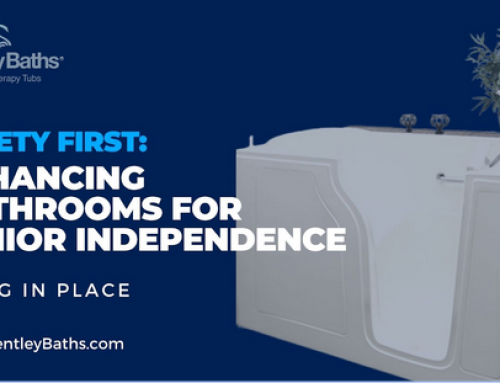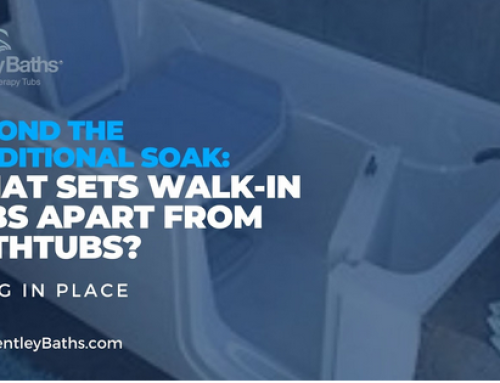In this blog I discuss currently available technological innovations that can allow us to remain safe while bathing in our own homes.
Calling Inspector Gadget!
Injuries from falling significantly impact our life expectancy and our quality of life. The smart thing to do is to prevent them from ever happening, and technological solutions are available to resolve the hazards involved in entering and exiting traditional bathtubs and showers. I myself discovered a technology called walk-in bathtubs during the course of trying to help my father. These tubs are engineered with a high sidewall and a door for entry and exit, with a seat permanently integrated into the bathing well inside the tub. Some of these appliances have outward swinging doors and some of them have inward swinging doors. Either way, one has the ability to enter and exit the tub with a very low threshold. Once seated in the tub, one is perfectly safe. You cannot fall in and you cannot fall out of it.
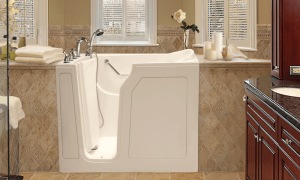 If the bathtub is appropriately selected based on the bather’s body size and mobility issues, it has immense potential to empower all of us to live independently in our own homes for the rest of our lives and never be forced into a nursing home because of our inability to bath safely at home. I tell my customers that if you are living in the home you hope to stay in and are over the age of 65, investing in a walk-in bathtub or safe bathing appliance to make your bathroom safer is a necessity, not a luxury! It is basically a no-brainer.
If the bathtub is appropriately selected based on the bather’s body size and mobility issues, it has immense potential to empower all of us to live independently in our own homes for the rest of our lives and never be forced into a nursing home because of our inability to bath safely at home. I tell my customers that if you are living in the home you hope to stay in and are over the age of 65, investing in a walk-in bathtub or safe bathing appliance to make your bathroom safer is a necessity, not a luxury! It is basically a no-brainer.
Transition Tubs and Showers
There are also transition tubs, a more extreme approach to the bathing appliance. They are designed for individuals with more advanced mobility issues, especially those who rely heavily on walkers, wheelchairs and other assistant devices. Most transition bathtubs are engineered so that the bather can transition directly on to the seat inside the tub and then close the door. Again, if properly sized and installed, the bather will be able to enjoy safe, stress-free bathing for the rest of his or her life.
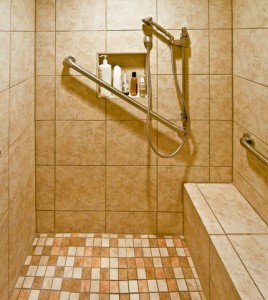 Walk-in or roll-in showers are very commonly relied on as a replacement for traditional bathtubs. While these fixtures may eliminate the danger related to the high threshold in a traditional bathtub, they do not address the safety issues of transitioning into and out of the shower. However, with appropriate engineering and design, it is possible to fit the shower system with sufficient grab bars and stabilization devices to make it safer. If you acquire a shower system that has an integrated bench, then you will also eliminate the “rain-dance” risks of having to stand and shower throughout the entire bathing process.
Walk-in or roll-in showers are very commonly relied on as a replacement for traditional bathtubs. While these fixtures may eliminate the danger related to the high threshold in a traditional bathtub, they do not address the safety issues of transitioning into and out of the shower. However, with appropriate engineering and design, it is possible to fit the shower system with sufficient grab bars and stabilization devices to make it safer. If you acquire a shower system that has an integrated bench, then you will also eliminate the “rain-dance” risks of having to stand and shower throughout the entire bathing process.
That said, I do consider showers to be a poor rest-of-life solution because they eliminate our ability to bathe and soak in a deep soaking environment, and can never provide complete safety and stability. For that, a walk-in or slide-in bathtub is necessary.
Band-Aid “Solutions”
The next option in terms of complexity and cost would be processes designed to modify the existing bathroom appliances. I refer to these as Band-Aid responses. A Band-Aid is not a permanent solution, and neither are things like suction-cup grab bars, clamp on grab bars, and moveable grab bars. They are not permanently fixed in the bathing environment. However, there are some mid-level technologies that greatly increase the safety at an only slightly higher cost than the Band-Aids. These mid-level solutions include:
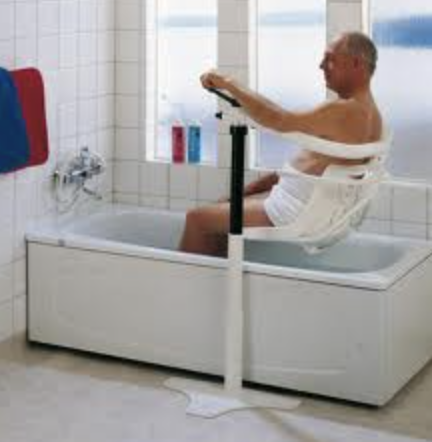 Tub lifts: The most common tub lift used today is basically a chair that sits inside the existing bathtub bathing well and is powered to lift the bather from the floor of the tub up to the height of the sidewall. This way, the bather can sit on the lift in the higher position and bring their legs over the sidewall of the tub and, if possible, into the tub, and then lower themselves down using the power chair. While this will definitely assist with the “getting up off the floor issue”, it does not address the problem of getting one’s legs over the threshold and into the tub. Most people I’ve interviewed are drawn to the idea of a tub lift because they want to try to preserve their ability to soak in a bathtub. However, because the water in most tubs is only 18 to 22 inches deep, and the tub lift equipment takes up some of that space, it’s a serious downside that the bather won’t be able to soak comfortably in the tub.
Tub lifts: The most common tub lift used today is basically a chair that sits inside the existing bathtub bathing well and is powered to lift the bather from the floor of the tub up to the height of the sidewall. This way, the bather can sit on the lift in the higher position and bring their legs over the sidewall of the tub and, if possible, into the tub, and then lower themselves down using the power chair. While this will definitely assist with the “getting up off the floor issue”, it does not address the problem of getting one’s legs over the threshold and into the tub. Most people I’ve interviewed are drawn to the idea of a tub lift because they want to try to preserve their ability to soak in a bathtub. However, because the water in most tubs is only 18 to 22 inches deep, and the tub lift equipment takes up some of that space, it’s a serious downside that the bather won’t be able to soak comfortably in the tub.
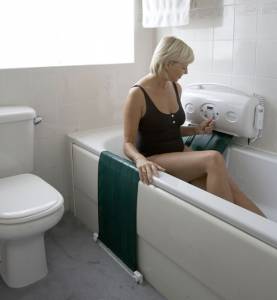 Sling-lift mechanisms: If we are financially required to look at lower-cost solutions and can take advantage of a lift-type mechanism by getting our legs into the tub, I strongly recommend a belt or sling-type system as a lift. This technology uses a sling or fabric band that runs across the width of the bathtub. It is secured and is lowered by an electric motor that allows the bather to lower all the way down to the floor of the tub with only the minimal thickness of the sling material between the bather and the bottom of the tub. I find this far more useful because it permits the bather to experience virtually all of the original soaking depth that they had with their traditional bathtub.
Sling-lift mechanisms: If we are financially required to look at lower-cost solutions and can take advantage of a lift-type mechanism by getting our legs into the tub, I strongly recommend a belt or sling-type system as a lift. This technology uses a sling or fabric band that runs across the width of the bathtub. It is secured and is lowered by an electric motor that allows the bather to lower all the way down to the floor of the tub with only the minimal thickness of the sling material between the bather and the bottom of the tub. I find this far more useful because it permits the bather to experience virtually all of the original soaking depth that they had with their traditional bathtub.
Tub-cuts: Once we determine that we cannot get our legs over the sidewall of the bathtub and into the bathing well, and we cannot afford to do the more appropriate solution of a permanent walk-in bathtub or transition tub, it is possible to consider the process of converting our existing traditional bathtub into a shower. We can accomplish this by cutting out the sidewall of the existing bathtub in order to allow entry and exit as if the bathtub were a shower. It will be easier to get in, but it will be no safer than a regular shower, and we are still facing all the slip-and-fall issues of a regular shower or bathtub. If we combine a tub-cut with a bench or a seat that permanently installed in the tub, then we can have a functional shower with a bench scenario. However, we will not ever be able to soak and bath in this type of setting, and we will also always continue to be less 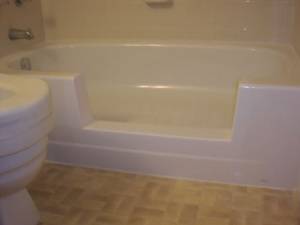 stable.
stable.
Tub-cut with a door: One solution is a hybrid between the tub-cut shower option and the chair-lift soak problem. In other words, if I cannot get my legs over the sidewall of the tub, even with a seat to sit on, then I’m going to have to remove the height of the sidewall to be able to get in.
Addressing These Issues
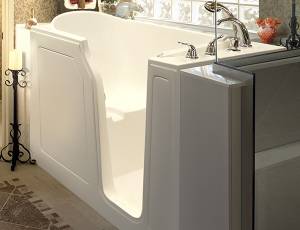 Again, this is the beauty of the engineering behind a walk-in bathtub, as it addresses these issues. If I cut the sidewall of the tub to get my legs in, then there’s no reason for me to lower myself through a tub lift or other device because I cannot fill the tub with water. The hybrid tub with a door approach is actually a tub-cut insert, meaning that we remove the material around the sidewall of the tub to allow access. The insert we install in place of the sidewall actually has a door configured into it. Like a walk-in bathtub, you can step into the tub and close that door behind you, so the bathtub can hold water. If we combine this with the safety-lift harness system mentioned earlier, we can now enter the tub easily, fill the tub with water, and lower ourselves onto the floor. This “hybrid approach” is the only way that we’ve determined that would keep the existing bathtub in place and permit the bather to have the safety of entry and exit, and the convenience of being lifted from the floor to the bathtub.
Again, this is the beauty of the engineering behind a walk-in bathtub, as it addresses these issues. If I cut the sidewall of the tub to get my legs in, then there’s no reason for me to lower myself through a tub lift or other device because I cannot fill the tub with water. The hybrid tub with a door approach is actually a tub-cut insert, meaning that we remove the material around the sidewall of the tub to allow access. The insert we install in place of the sidewall actually has a door configured into it. Like a walk-in bathtub, you can step into the tub and close that door behind you, so the bathtub can hold water. If we combine this with the safety-lift harness system mentioned earlier, we can now enter the tub easily, fill the tub with water, and lower ourselves onto the floor. This “hybrid approach” is the only way that we’ve determined that would keep the existing bathtub in place and permit the bather to have the safety of entry and exit, and the convenience of being lifted from the floor to the bathtub.
There’s no question that the best solution for rest-of-life convenience is to invest in a walk-in bathtub or transition tub, in order to keep us bathing safely and in our own home for life.
Stay tuned for the next installment of the Bentley Baths blog, in which I detail the injuries that can result when water temperature isn’t correctly monitored and controlled.







